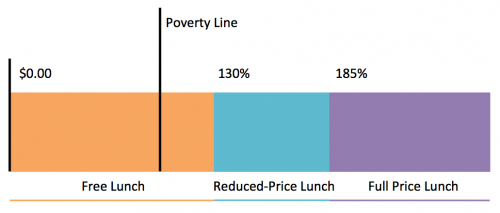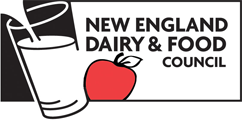The National School Lunch Program has been around since 1946 and currently feeds 31 million American children every weekday. Participation is voluntary, but enrollment allows the school’s food service department to be reimbursed for meals served.
But what are kids eating?
In this blog post, you’ll learn about:
- How the price per student is set.
- What the school lunch program pays.
- What counts as lunch.
- Specific nutrition guidelines.
How Much Does a Student Pay for Lunch?
This depends on the child’s household income and how it compares to the nationally set poverty level.
For July 1, 2016 through June 30, 2017 throughout New England, the poverty level was set at $24,300 for a four-person household. This means that for a family of four, two parents need to earn a combined total of $24,300 per year.
For a child to be eligible for a free school lunch, the household would need to make $31,590 or less (or $24,300 x 1.30). Sometimes you’ll see this written as “at or below 130-percent of poverty level.”
A reduced-price meal means that a household earns between $31,590 and $44,955, or 130- to 185-percent above the poverty level.
Above $44,955, the child is expected to pay full price for lunch.

How Much Does the School Lunch Program Pay?
A meals program will be reimbursed $3.22 for a free meal served, $2.82 for a reduced-price meal, and $0.36 for a full price meal. This means that if a meal costs $4.00 to produce then no pricing category will cover the true cost of lunch. Note that this cost includes labor. Smart menu planning, efficient food contracts, and creativity by a school’s food service department are critical.
Remember that a school is only reimbursed for those lunches that meet the NSLP guidelines.
So What Counts as Lunch?
Now that we know the pricing structure, let’s dive into what count as a reimbursable lunch.
An NSLP-approved daily lunch menu must offer at least five of the below items:
- A half-cup serving of fruit
- A half-cup serving of vegetable
- A 1-ounce equivalent of whole grains
- A serving of meat or meat alternate
- An 8-ounce serving of milk
Of these five items, at least three create a reimbursable meal. One of the three items must also be a half-cup serving of fruits or vegetables.
Specific Nutrition Guidelines
While the above “must choose three” list is for every lunch served, calories, sodium, and saturated fat for lunch are averaged across the week. Trans fat levels must be met on a daily basis.
So how are nutrient levels determined? This is based on the student’s grade level.
For instance, an average lunch for K-12 students includes:
- 550-850 calories
- 10-percent or less of total calories from saturated fat
- 0.5 milligrams or less of total calories from trans fat*
- 1,080 milligrams or less of sodium**
The weekly lunch menu must also include dark green, red/orange, and starchy vegetables, plus legumes (dry beans and peas).
Lastly, at least two of the following fluid milk products must be offered:
- Fat-free milk: Flavored, unflavored, lactose-reduced, and lactose-free.
- Low-fat milk (1%): Unflavored, lactose-reduced, and lactose-free.
Take Home Message: School Lunch is Complicated
There’s a lot of math and planning that goes into what your child eats at school. Rest assured that they’re receiving a variety of nutrient-rich options.
* Naturally occurring trans fat are excluded (e.g., dairy products).
** Based off of the current sodium reduction timeline. The 1,080-milligram amount is the maximum allowable weekly average limit for a grade 9-12 student.
Updated April 11, 2017


